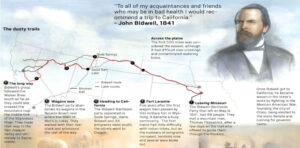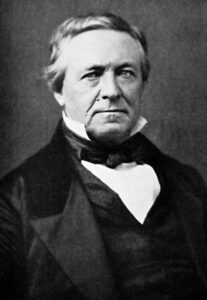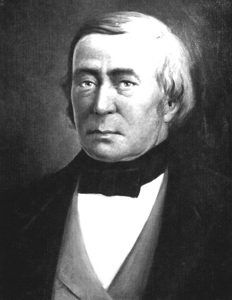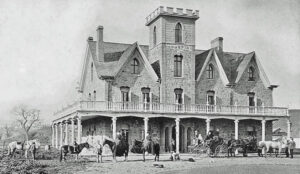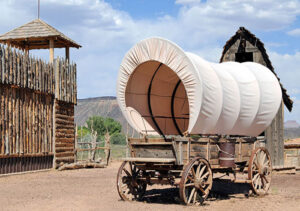The Bidwell-Bartleson Party, led by Captain John Bartleson and John Bidwell, became the first American emigrants to attempt a wagon crossing from Missouri to California.
In the winter of 1840, the Western Emigration Society was founded in Missouri with 500 people pledging to trek west into Mexican California. Members included Baldridge, Barnett, Bartleson, Bidwell, and Nye. The Society resolved to follow the route suggested by Dr. John Marsh, who owned a great rancho in California. As early as 1837, Marsh realized owning the rancho was problematic if he could not hold it. The corrupt and unpredictable court rulings in Mexican California made this questionable. With evidence that the Russians, French, and English were preparing to seize the province, he determined to make it a part of the United States. He felt that the best way to go about this was to encourage emigration by Americans to California; in this way, the history of Texas would be repeated.
Marsh conducted a letter-writing campaign espousing the California climate, soil, and other reasons to settle and suggested the best route to follow, known as “Marsh’s Route.” His letters were read, reread, passed around, and printed in newspapers throughout the country, and he started the first significant immigration to California. He invited immigrants to stay on his ranch until they could get settled, and he assisted in obtaining passports.
The caravan was organized on May 18, 1841, when Talbot H. Green was elected president, John Bidwell secretary, and John Bartleson captain. Numbering more than 60 people when it was assembled at Sapling Grove, near Westport, Missouri, its most active organizer was twenty-one-year-old John Bidwell, who kept a daily diary of the journey.
The Bidwell-Bartleson Party joined Father Pierre Jean De Smet’s Jesuit missionary group, led by renowned mountain man Thomas “Broken Hand” Fitzpatrick. The group moved westward across South Pass along the Oregon Trail past Courthouse and Jail Rocks, Chimney Rock, Scotts Bluff, Fort Laramie, and Independence Rock. At Soda Springs, Idaho, the Bidwell-Bartleson Party separated from Fitzpatrick, and the missionary group, on August 11, 1841. About half of the original party decided to play it safe and continue to Oregon.
“The water is strongly impregnated with soda, and wherever it gushes out of the ground, a sediment is deposited, of a reddish color, which petrifies and forms around the springs large mounds of porous rock, some of which are no less than fifty feet high.”
— John Bidwell – Caravan President
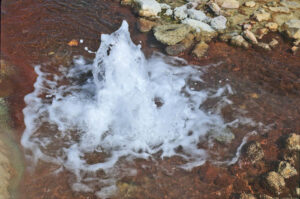
Soda Springs, Idaho courtesy Roy D. Sea, Science Views.
As the Jesuit priests and Fitzpatrick split off to Oregon, the 34 California trail pioneers followed vague directions and carried on with determination to reach California. Marsh’s recommended route from Soda Springs led southwest along the Bear River and the Cache Valley. It was based on the prior experiences of Jedediah Smith, Peter Skene Ogden, and Joseph R. Walker.
The party was now made up of 32 men and 18-year-old Nancy Kelsey and her infant daughter. Barely 18 years old, Kelsey carried a baby daughter in one arm and led a horse with the other. She was later remembered for her “heroism, patience, and kindness.”
As the first overland party to travel to California, this brave group of westward-bound emigrants blazed a new trail – the California Trail – to make history.
The more committed members, holding to their original destination, started south in nine wagons “with no guide, no compass, nothing but the sun to direct them” toward the present border of Utah.
They crossed the 42nd parallel into Utah on August 16 and camped near present-day Clarkston. Intending to rest in Cache Valley, while several men sought directions at Fort Hall, Idaho, the party mistakenly crossed the low range just north of the Gates of the Bear to arrive in the Great Salt Lake Valley near present-day Fielding. On August 24, 1841, the party headed west and north around the Great Salt Lake, camping in the vicinity of the Hansel Mountains until September 9 while they scouted the route to the Humboldt River. Nancy Kelsey was the first white woman to see the Great Salt Lake six years before the Mormon pioneers began to arrive.
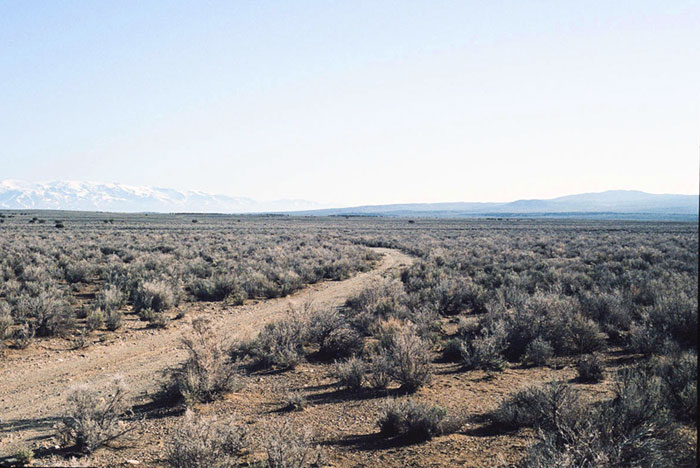
Bidwell Trail courtesy Roy D. Sea, Science Views.
On September 11, Kentuckian Benjamin Kelsey abandoned his wagons and put his wife and baby on horseback. Two days later, the emigrants were the first of many to arrive at Pilot Peak on the Utah–Nevada border and find relief at the freshwater springs at its base. Soon other emigrants would also abandon their possessions. The remaining wagons were abandoned at Relief Springs in Gosiute Valley, east of Wells, Nevada, where the wagons were found in 1846 by emigrants traveling on the Hastings Cutoff.
By October 9, they crossed the Humboldt River and headed west to Lake Humboldt, Humboldt Sink, and Carson Sink. On October 30, they passed through the Stanislaus River Canyon into the San Joaquin Valley.
On November 4, 1841, the party made it to John Marsh’s Los Medanos Rancho at the foot of Mount Diablo in present-day Contra Costa County. The latter part of the journey was challenging as there were few water sources, the party nearly starved, and they arrived destitute and almost naked. Arriving at the cusp of winter, the party spent time at the ranch recovering their strength and restocking supplies. Later, the party split up to their final destination in California.
Some members of the Bartleson-Bidwell company later gained renown, including Bidwell and noted trails captain Joseph B. Chiles. John Bidwell went on to work for John Sutter at Sutter’s Fort in Sacramento, California and became an established leader as a general, congressman, and senator. Not much is known about “Captain” John Bartleson. Benjamin Kelsey, the husband of Nancy Kelsey, was known for his bravery and pioneering spirit. Nancy Kelsey died in California at age 73.
“…the Bidwell-Bartleson party had successfully made the first planned overland emigrant journey to California, bearing with courage and great fortitude the vicissitudes of their ordeal. These hardy pioneers were the harbingers of many thousands to come.”
— Doyce Nunis, Historian and Author
Visitors today can learn about the emigrant party that started it all at the California Trail Interpretive Center in Elko, Nevada. Visitors can see replicas of the wagons they traveled in, follow their progress with interactive exhibits and activities at the Pioneer History Museum, attend events, and research additional information at the library. The California Trail Interpretive Center is located at 3900 E Idaho Street in Elko, Nevada.
© Kathy Alexander/Legends of America, updated April 2023.
Also See:
Adventures in the American West
Tales & Trails of the American Frontier
Sources:
Bureau of Land Management
California Trail Interpretive Center
History To Go Utah
Science Views
Wikipedia

